How to work with an angle grinder correctly: safety precautions + instruction manual
Are you planning to use a power tool while doing home repairs, but don’t know how to work with an angle grinder correctly so as not to injure yourself? Agree, it would be unwise to unknowingly break a disc in the first minutes or, even worse, injure yourself.
Or have you just decided to acquire a power tool and are studying the rules of its operation in advance? In this case, pay attention to the products of famous manufacturers with a good reputation, who sell really high-quality devices of excellent assembly with a long-term guarantee.
After all, it is safer to work with a reliable tool. One of the excellent options is products from the Bosch, DeWalt, Makita brands, as well as Metabo angle grinders, sold in a wide range. We will look at the operating rules and main mistakes when working with this type of power tool in detail in our article.
The material, in addition to recommendations for using an angle grinder, contains visual photos of working with an angle grinder and useful video tips from experienced users. Having familiarized yourself with the latest and observing the rules of personal safety, you will be able to cope with the chiselling of a concrete wall, cutting tiles or bricks on your own, without involving specialists for these tasks.
The content of the article:
Types and features of using angle grinders
The popularly known grinder is nothing more than an angle grinder. This power tool, according to ordinary people, is necessary for every owner who has the slightest bit of self-respect.
It is not surprising, because in addition to grinding, the device is capable of performing high-quality cutting of various types of materials, ranging from simple wood to metal corners and fittings.
Most often in everyday life, this tool is used not for grinding operations, but specifically for cutting materials.
Main types of grinders
This useful and almost universal power tool can not only saw and cut, but also grind the surface with emery wheels, clean off rust with metal brushes and, if you have a special diamond wheel, carefully cut glass.
But not every angle grinder model has a wide range of capabilities. And technical characteristics, such as power, revolutions per minute, recommended disc diameter and the list of possible operations, vary.
In addition, all grinders presented on the power tool market can be divided into the following categories based on operating time and endurance:
- For household use – this type involves use purely at home to perform simple tasks. The operating time of such models is up to 40 minutes.
- For professional use – this category of power tool is designed for a daily load of 3-4 hours. Similar models are used by craftsmen performing “turnkey repairs” and other types of repair work.
- Industrial – machines, it’s even awkward to call them simply “grinders,” designed for continuous use by an angle grinder operator all day long.
While the first two types are common among the population, the latter are used exclusively in large enterprises working with serious objects. And increased demands are placed on an employee applying for the position of operator.
In particular, knowledge of the design of a power tool, the principle of its operation, the technology of performing work with its help, and knowledge of and compliance with personal safety rules.
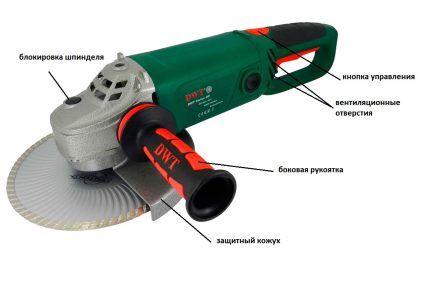
In addition, devices can be classified according to the type of power supply: mains-dependent and rechargeable. And also divide into groups according to cost and other criteria.
Subtleties of using power tools
Before you learn how to make an even cut, you need to figure out how to use a household grinder correctly so as not to damage yourself.
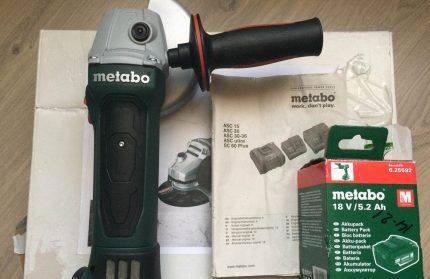
But you shouldn’t ignore the instructions, because an angle grinder is not only a useful tool on the farm - The grinder is also extremely dangerous in the hands of an inexperienced operator.
There are frequent cases of serious injuries to the face, limbs, and torso due to careless handling of the device. Eyes are even more likely to suffer from scale, sparks and other foreign objects if they are not properly protected.
Moreover, no one is insured against an accident - even experienced users who have been working with an angle grinder for 20-25 years, by coincidence, find themselves visiting the emergency room.
Therefore, it is important, first of all, to protect yourself with personal protective equipment (PPE).
Another item that guarantees a certain level of protection, which the manufacturer insists on using, is the protective cover supplied with each type of cutting wheel. It is important to put it on before installing the appropriate attachment and adjust it well.
Step-by-step instructions on using an angle grinder
Having dealt with PPE, let’s look at how to cut correctly with a grinder – sparks “towards you” or “from yourself”. More details about the direction of sparks later in the article.
True, this point is the subject of heated debate among numerous angle grinder owners. And each user provides compelling arguments in favor of their point of view.But they agree on one thing - you need to work in such a way as to protect yourself as much as possible.
Let's look at step-by-step instructions for working with an angle grinder.
Step #1 - Cleaning the Workplace
Before starting work with an angle grinder, you should remove as much as possible everything unnecessary in the work area - bars, buckets with solution, coils with cables, plastic film and other useful things.

There should be nothing unnecessary under your feet or on the working surface that the grinder could accidentally get caught on.
Step #2 - preparing the material for work
An equally important stage is the preparation of the material. To avoid problems with angle grinder processing, you need to securely fix it. For this they use vice, clamp, clamps and other devices capable of holding a board, corner, pipe, etc. in place.
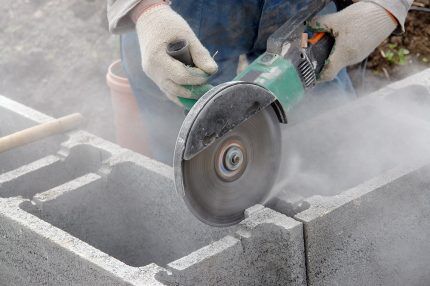
You cannot use parts of your body – arms, legs, torso – as holders. Also, you should not involve an assistant who will support the pipe or brick in the desired position - if the tool gets out of control, the consequences will be disastrous.
Step #3 - preparing the tool for use
The process of preparing an angle grinder should begin with the selection of the necessary attachment - recommended by the manufacturer for a specific task.
It is important to carefully inspect the selected disc from all sides and if any cracks, nicks, chips or other problems are found, discard it immediately.
As a rule, branded angle grinder models are equipped with several types of devices:
- universal cutting wheels;
- diamond bits for cutting durable materials;
- circles for working on concrete;
- different types of grinding attachments;
- metal brushes.
The number and range of additional accessories depends on the model purchased. Often, universal circles have to be purchased separately, and their cost is quite high.
For comfortable operation of the grinder, you can use additional accessories. It's a pity that not all manufacturers supply them as a set.
The set of additional accessories depends on the angle grinder model and its capabilities. The manufacturer must inform owners about this in the instructions. Moreover, it prescribes what is strictly forbidden to do.
No less important is the diameter of the cutting wheel and the recommended rotation speed - the number of revolutions per minute should exceed this parameter for an angle grinder. You should not install large nozzles - there is a risk of injury.
All work on changing the disk must be performed with the device completely disconnected from the network.
The correct installation of the disk is demonstrated in the operating instructions. Moreover, some branded electrical appliances provide only one option for placing the cutting disc.
Step #4 - initial launch and testing
If the process of preparing the tool is completed and the desired disk has taken its place, let’s consider how to properly and safely hold a working grinder in your hands.
This point is especially useful for beginners who do not yet have experience using an angle grinder. First you need to properly pick up the machine and take a stable position.
Firstly, take the device in such a way as to ensure that the “spark is directed towards you” - this is a symbol for the position of the angle grinder.
The plane of the circle is located strictly parallel to the plane of the user’s body, and the head is strictly outside the plane of the same circle.
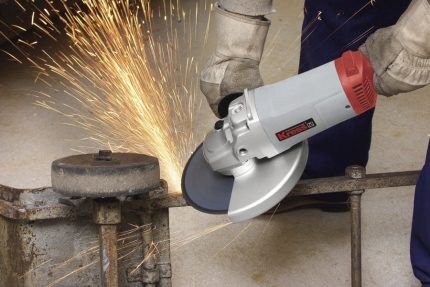
Secondly, the additional or auxiliary handle screwed to the body of the angle grinder must be occupied by the right hand. This is for a right-handed person. The point is to have a strong hand guide and control the movement of the tool.
Thirdly, the on/off button and power adjustment are controlled by the left hand. Which holds the device by the handle on the body, if there is one.

As for the angle grinder, it must be positioned to the left of the operator’s body, without touching the latter. Body position – legs stand firmly on a hard surface, right shoulder and arm lean forward.
In this position, you need to practice idle so that your arms and legs get used to the desired position.
Then you have to turn on the grinder and wait about a minute for the disc to accelerate. After this, you can proceed directly to work.
Step #5 - Perform cutting or sanding
If this is your first time picking up a power tool and you don’t know how to properly cut a metal pipe with a grinder, don’t worry. First, carefully read the manufacturer's recommendations and only then start cutting.

When cutting, you should hold and guide the tool, avoiding excessive pressure on the handle. Cutting is performed using the edge of the nozzle.Moreover, jerking and sudden movements are contraindicated - such behavior of the grinder is fraught with failure of the cut.
It is also important to control the depth of the circle’s entry – it should not be large. The less the nozzle is immersed in the material, the less wear it will have. And the less danger of getting stuck in the cut.
When performing grinding, it is important to use strictly designated equipment. These are special wheels - cleaning wheels. They most often come with a casing that will prevent the scattering of small particles that appear during the surface cleaning process.

If you are cleaning with circles with metal bristles, then you need to be extremely careful with them - such a harmless attachment during the processing of the part loses pieces of bristles that fly in different directions and can injure parts of the operator’s body, piercing protective clothing.
Tips for beginners and main mistakes
Experienced angle grinder users recommend that beginners buy an angle grinder from a well-known brand, with instructions in Russian and a convenient button located on the body “under your fingers.” To begin with, it is better to get a device with a power of up to 1 kW.
Such a tool costs about 5 thousand rubles, but personal safety and health are much more expensive - you cannot save much on an angle grinder.
Another tip concerns discs - it’s better to take branded ones and the right size. They are more expensive, but cheap Chinese ones are very thin and explode ten times more often.
Some grinder owners may argue about the thickness, arguing that a thin disc causes less injury in the event of an explosion, especially with a diameter of 115 mm.
But their opponents make a fairly compelling argument in favor of branded and thicker ones - they do not explode, unless used incorrectly. And the service life of the latter is longer.
The following are common mistakes when working with an angle grinder, which can result in disability or death.
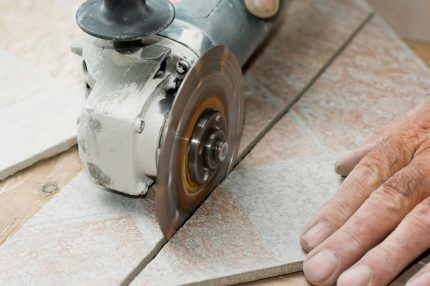
Mistakes when working with an angle grinder:
- Ignoring protective equipment – hands without gloves suffer from sparks, scale when working with metal, concrete particles and other things.
- Using your own legs as a vicewhen you need to hold bricks or other materials being processed, this is a grave mistake.
- Unauthorized improvement of a tool not adapted to these needs, for example, a makeshift water supply, if the manufacturer indicates that the machine cannot be used with water, which could result in an electric shock.
Among the mistakes, the most important one should be highlighted - using an angle grinder while drunk or under the influence of psychotropic drugs. Which is strictly prohibited.
There is also no need to rush, leave the instrument plugged in or put it aside immediately after turning it off - first you need to wait until the disk stops.
We also have other useful articles on our website about another dangerous power tool - a welding machine. In which the rules for performing electric welding work for beginners and instructions for making horizontal and vertical seams are discussed.
To familiarize yourself with the material, please follow these links:
- Electric welding for beginners: rules and nuances of welding + analysis of the main mistakes
- How to weld vertical and horizontal seams using electric welding: analysis of methods + instructions
Conclusions and useful video on the topic
Video material about using angle grinders and recommendations for beginners:
A grinder can become an indispensable assistant for those who like to do everything with their own hands. But it can also injure you if you hold the power tool incorrectly, do not follow simple operating rules, or ignore protective devices.
If you use the machine for its intended purpose, install the discs recommended by the manufacturer, hold it confidently in your hands and stand firmly on your feet, then working with this power tool will be a joy.
Are you studying the rules for safe use of an angle grinder and want to clarify a couple of points that we did not pay attention to in this article? Ask your questions in the block below - our experts will try to help you.
Or are you a professional power tool user and want to give some useful tips to beginners? Write your recommendations in the comments block, if necessary, add unique photos of your grinder or its individual elements.




Small one-handed grinders are not so scary, although they also have a lot of revolutions. But at 230 the disc is already a powerful “beast”.
I decided for myself not to take cheap luga type wheels, they fly apart many times more than normal ones. The main thing is to tighten the nut correctly so that there is no distortion or runout of the disk. And don’t be lazy to redo it, reinstall it if the disk wobbles.
And under no circumstances should you remove the casing; once was enough for me; I saw a guy get hurt in the next garage. Now I double-check it ten times and put on protection.
It's like that. I also note that each disk has a limit on permissible speed. Especially the inexpensive ones. I stopped taking them after two in a row flew apart as soon as I gave it a little revs.
An angle grinder is like a snake - you can pick it up, but with all the prescribed safety measures, otherwise this useful tool turns into a little killer. It's surprising that they haven't yet come up with some safer analogue.
I also have an angle grinder, a Russian manufacturer, despite the fact that nowadays you can’t find a domestic tool during the day. On the topic of safety measures, first of all, I will repeat what has already been written above - IN NO EVENT DO YOU REMOVE THE COVER FROM THE GRINDER! Your attempt to install a larger diameter disc can cost you very dearly. It is also important when working with an angle grinder in which direction the disk rotates relative to a person and, accordingly, sparks fly. One more thing - start-up. There are models with a soft start option. They are more expensive, but not much. There are models without this option. The smooth start of the angle grinder is also a safety benefit, so I advise you to pay attention to this. The fact that a person should always use personal protective equipment (face helmet, gloves) is not discussed at all.